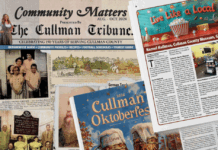A Christmas tree decorated with Chrismon symbols and other ornaments at Oak Level Baptist Church near Holly Pond / W.C. Mann
As we count down to Christmas, The Tribune decided to take a look at some things folks often do during the Advent/Christmas season, both ancient traditions and some fairly recent developments.
The Christmas tree
All the way back in pre-Christian times, Romans who followed certain pagan religions decorated their homes with evergreen branches to remind themselves through the bleak winter months that spring was coming. The Roman festival of Saturn, the Saturnalia, occurred between Dec. 17 and 23 and included the use of fir trees to decorate temples, and the giving of candles as gifts.
Christians may have continued the use of evergreen while redefining its significance as a representation of eternal life, but the use of trees as a liturgical decoration does not appear to have begun in earnest until the 1400s. Fir trees or artificial representations of trees were used in the Church festival of Adam and Eve on Dec. 24, where their evergreen-ness reminded parishioners of the Tree of Life in the Garden of Eden, and apples that decorated the trees reminded them of the Tree of the Knowledge of Good and Evil that Christians believe led to mankind’s fall. These trees stood in town squares, and were the centerpieces of community dances and general fun until the end of the festival, when they were set on fire.
Trees began to be brought into homes and not set on fire in the 1500s in Germany, in an early Lutheran tradition that some say goes back to Martin Luther himself. By 1600, the decorating of German homes with trees for Christmas Day had become common. The tradition came to Britain in the 1830s, and from there to America in the 1850s. Today, evergreens remain the standard, but live candles that once decorated trees that were intended to burn have been replaced with electric lights, and live fruits have been replaced with other ornaments.
The Chrismon tree
A modern American take on the Christmas tree, that has caught on in some churches across the country, is the Chrismon tree. The new tradition began with Mrs. Frances Kipps Spencer at Ascension Lutheran Church in Danville, Virginia in 1957.
“Chrismon” is a combination of “Christ” and “monogram,” and refers to various symbols that represent Jesus. They are presented in white with gold trim, according to Ascension Church’s website, “to symbolize the purity and majesty of the Son of God and the Son of Man;” and take the forms of crosses, fish (the early Christian ichthus), stars, crowns, the chi-rho and alpha-omega monograms, as well as others.
Copyright 2017 Humble Roots, LLC. All Rights Reserved.































